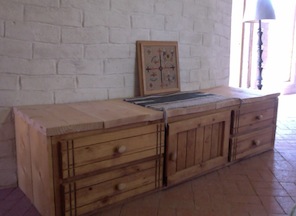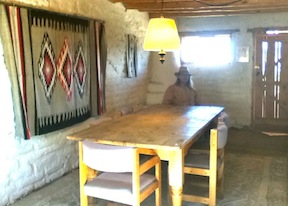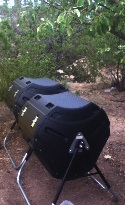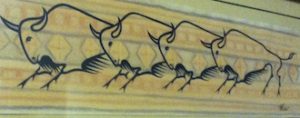Donor Acknowledgement
Home » Articles and News » Donor Acknowledgement
Report from Laura Lee, Director of Outreach and Development
CI has been blessed with many gifts recently.
Kim Miller, and The Lester and Bernice Smith Foundation, both donated a significant sum for refurbishing the grounds and facilities at CI. This generous contribution allowed us to accomplish a lot, and quickly. Paul and I arrived three weeks before our June workshop, so this was the window to get CI upgraded and ready for the workshop season. We were thankful to have the funds on hand so we could get right to it.
The first project Paul tackled was the kitchen. He wanted to expand it, as meal prep for a dozen people, by four or five, gets rather congested in a tiny kitchen! For the wall where a long plastic table had stood, Paul found nine feet of matching cabinets at the Habitat for  Humanity charity store, plus a counter top to fit. That adds a lot of work space, plus storage. He found a tall pantry cupboard to replace the metal cabinet, and reworked the cabinets around the stove to accomodate the newer, larger stove that Jackie Haworth donated. Thank you Jackie, for the stove, and just in time! The old one blew up while we were waiting for the new one to arrive. Also, Jack and Diana Scott made a much-appreciated contribution to this kitchen project. We ran into Steve Thomas, former host of “This Old House,” who we knew from my previous interview with him regarding his years spent with a Polynesian elder, one of the last who knew the old ways of navigation by the stars, waves, and birds. Steve’s new gig is spokesman/ambassador for Habitat for Humanity, and it was his turn to interview us for his blog, about why we were shopping at the Habitat store. We needed vintage cabinets, we told him. We couldn’t afford to rip out all the kitchen cabinets in order to expand them. We were lucky that we found older, recycled cabinets that exactly match what we have already.
Humanity charity store, plus a counter top to fit. That adds a lot of work space, plus storage. He found a tall pantry cupboard to replace the metal cabinet, and reworked the cabinets around the stove to accomodate the newer, larger stove that Jackie Haworth donated. Thank you Jackie, for the stove, and just in time! The old one blew up while we were waiting for the new one to arrive. Also, Jack and Diana Scott made a much-appreciated contribution to this kitchen project. We ran into Steve Thomas, former host of “This Old House,” who we knew from my previous interview with him regarding his years spent with a Polynesian elder, one of the last who knew the old ways of navigation by the stars, waves, and birds. Steve’s new gig is spokesman/ambassador for Habitat for Humanity, and it was his turn to interview us for his blog, about why we were shopping at the Habitat store. We needed vintage cabinets, we told him. We couldn’t afford to rip out all the kitchen cabinets in order to expand them. We were lucky that we found older, recycled cabinets that exactly match what we have already.
Vintage and recycled was the theme that carried us through the entire project — that, and to have just what we needed appear, when we needed it! We bought new as appropriate, as needed; but where we found items, ready and willing to be repurposed, we were glad to do so — it helped us maintain the rustic simplicity that is part of the charm here at CI. Not to mention, stretching our funds to accomplish even more!
Part of the fun was that we seemed to have slipped into some higher order shopping groove; just when we added some unusual item to the list, it seemed to appear. One day we were wondering how to handle the recycling of jars and plastic and paper, the next day, as we were looking for something else, we found a practically new recycling unit with three lidded bins that just fits under the kitchen window. I bought many, many kitchen items to make food prep and clean up easier: cutting boards, pots, serving dishes, flatware, towels, racks, mitts, an assortment of tools and utensils, as well as big serving trays to make the trek from kitchen to dining table more efficient.
For the dining hall and entry of the student building, we rearranged what furniture was here, and added a few new pieces. You’d be amazed what is donated to charity shops, in the way of rustic, hand-made pine tables, sideboards, and other pieces we found. Happily, it all blends with what is already here, and was very affordable. Paul is good at seeing the potential in a piece, and repurposing. He found a long, low set of rustic pine drawers, that he remade into the bench seat now sitting at the entryway. He made a new top for it that fits the curve of the wall, now looks like its always been there. And a new, tightly fitting screen door should help keep critters out of the building. The bathrooms got a bit of a make-over: shelves were added, mirrors replaced, new hooks, and fresh paint on everything cleaned it right up.
 Paul found a gorgous trestle table with matching chairs on Craigslist. It is a hand-scraped, custom built set by renowned local artisans. The owner made a partial donation (–thank you Ken!) of it, and it’s ten-foot length comfortably seats full workshops. The former long skinny dining table has become the library table, with the addition of two library chairs, and a span of bookshelves.
Paul found a gorgous trestle table with matching chairs on Craigslist. It is a hand-scraped, custom built set by renowned local artisans. The owner made a partial donation (–thank you Ken!) of it, and it’s ten-foot length comfortably seats full workshops. The former long skinny dining table has become the library table, with the addition of two library chairs, and a span of bookshelves.
The landscaping project centered on making the pathways safer. Some paths were widened with additional flagstone. Some were raked and re-edged with rock. A torrential rain early on showed us where the water hitting the ground wanted to go so a french drain here and there was added, and a few channels dug to redirect it. I found solar path lights on sale for $2 each at Lowe’s, so I bought dozens and they now illuminate the paths at night. They are on the dimmer side, as we did not want to interfer with watching the stars. (see May Hsi’s gorgeous photo of the Milky Way over the casita). Now, as you drive down the hill at night into the complex of buildings, the solar lights make an enchanting welcome.
The next project was to make the bunk house more comfortable for guests. Paul removed the storage bins, making more room for the cots. He added carpets and Native American wall hangings, and a big rustic table with chairs and overhead hanging lamp. It was now so comfortable there — — its the coolest place to be on a hot day — that it was the preferred meeting place during our recent board meeting.
The casita needed to become a more usable dormitory as well. While it was the repository of Dr. Goodman’s artifacts and collections, it was also layered with dust and dead moths, and was no longer honoring her memory. So Paul and I brought in a lit candle, and sat down to reminisce about Felicitas, our time with her, how lucky we were to have known her, and learn directly from her. And to ponder, here was her special place, and here are her things, and what are we to do? I boxed everything up to make a fresh start. The casita is so small it can accomodate only two cots and the small, ornately carved wooden desk that was formerly the office desk. It has no electricity, so we hung vintage reflective candle holders on the wall, and brought in LED candles that can be switched on. For privacy we installed long white side curtains to the tall windows that look out onto the white buffalo side of the art-pole installation. Our workshop guests who stayed there said it was their favorite space.
I wanted to find a new way to honor Felicitas, to keep her memory present, and to better tell the story of who she was. She was an anthropologist, so I brought the glass case that was in the casita into the student building, and filled it some of her pots, figurines, and the baskets of pottery shards that have been found here over the years. (We keep finding them — a few were unearthed during the landscaping project, and we found a more during a hike over to Heart Rock and beyond). Felicitas was also a folklorist, and we’ve met people from the local pueblo who shared their fond memories, as children, watching the puppet shows she put on for them. What a great way to convey stories! No doubt she saw this as a valuable, often overlooked tool for cultural transmission. Her puppets, many of them she made herself, are now on display in a corner of the student building for all to enjoy.
We also want to thank the volunteers who put in many hours of work to help get CI ready for the season. Wendy Boxer vacuumed and scrubbed the buildings, washed sheets and towels, and keeps the humming bird feeders filled. Gene Bourquin shoveled dirt, sculpted pathways, placed rocks, and painted. Robert Stener installed steps by the kitchen door and the casita. May Hsi helped with office duties. Many, many heart-felt thanks to our volunteers — we could not do it without you! If you would like to volunteer for projects in the months ahead, contact Paul. Your suggestions on what you would like to help with are welcome, or ask what projects are already on the list.
Again, we thank our donors, Kim Miller and The Lester and Bernice Smith Foundation, for the generous funds to accomplish so much in Phase One of the CI Refurbish Project. Thank you all for belieiving in CI, and helping to make this haven even more functional and beautiful.
Belinda Gore, CI’s Director of Training, who teaches around the world, has long been donating ten percent of her CI workshop income. Truly, she is ‘paying it forward’. Thank you, Belinda!
 Alan and Abby Ismond solved an immediate need with their donation to set up a new composting system. The old composter was attracting rodents and was hard to maintain. Alan specified two composters, so as one was filled and ‘cooking’ we had the next one to fill, and that they close securely and rotate to mix the materials. Thanks to the Ismonds we now have two new composters installed in the orchard, helping us express our green philosophy!
Alan and Abby Ismond solved an immediate need with their donation to set up a new composting system. The old composter was attracting rodents and was hard to maintain. Alan specified two composters, so as one was filled and ‘cooking’ we had the next one to fill, and that they close securely and rotate to mix the materials. Thanks to the Ismonds we now have two new composters installed in the orchard, helping us express our green philosophy!
Also near the orchard, at the edge of the parking lot, you will see a newly installed building measuring eight by twelve feet. This is the immediate solution to our need for a rodent-proof, easily-accessible, off-season storage. While it is currently bright yellow in color, the plan is to surface it with an adobe-colored material so it blends in with the existing buildings. This is part of Phase Two of the refurbishing of CI. We also have roofs to maintain, cracks in the adobe to fill, the well to upgrade, road repair, and much more on the list of ongoing maintenance.
Please consider donating towards keeping CI in good repair. And consider coming to workshops here, holding workshops here, and letting your friends know about workshops here. Also consider staying here as guests. A portion of all these fees goes towards land maintenance.
IN-KIND CONTRIBUTIONS
The buffalo held special meaning for Dr. Goodman, so Cynthia Devlin’s gift of art featuring four buffalo now graces the entryway to the student building. Thank you Cynthia for this and your additional gift of woven lidded basket.
Alfonz and April Vizsolay donated dozens of colorful mineral rocks, and a standing art shield that has found a place in the student building. The art has a fascinating story. Here is a recap, as told to Paul by Alfonz:
“This sculpture was originally made at a nearby pueblo in the 1920’s. During a visit to the pueblo, Alfonz found the parts in a pile. They were all falling apart and the metal was rusting away. Alfonz asked of he could rescue them from the “trash heap” and they agreed. Alfonz and his son Leonardo began restoration, piece by piece, with the help from members of the the pueblo, using as much of the original materials as possible. They re-cut new shields out of stainless steel to increase the the lifespan.
Upon completing the group of about forty shields, Alfonz invited the elders to his studio. They were deeply moved. Now, the shields will be gathered together each year for a winter sunrise ritual. As Alfonz puts it, in his dry sense of humor: ‘These were in a junk pile – we fix them – now they want them back.’ CI is honored to be a recipient of one of these shields.”
On behalf of CI, we thank all of our donors for their generosity and support.
Please consider these options when making a donation to the Cuyamungue Institute
Your financial support is vital to the long-term viability of this work, as well as maintaining the Institute, its activities, and headquarters in Santa Fe, NM. Ongoing-research, as well as new applications of our work, is only possible through donations made by people like you. These are extraordinary times, and it is good to include you as part of the story!
The Cuyamunge Institute is a registered 501(c)(3) charity under the United States Internal Revenue Code. Your donation is tax-deductible to the extent permitted by law.
Here are two options for making your donation:
- PayPal:
- Check or Money Order:
US Funds – Send a check or money order. Our address is:
The Cuyamungue Institute
20-A Feather Catcher Road
Santa Fe, New Mexico 87506
Our bank, Wells Fargo, does not charge any fees for our use of the bank account, or per-check processing fees. 100% of your intended donation amount goes to The Cuyamungue Institute. Donations of $100 or over will receive a written “thank you’ and you will automatically become a member of The Cuyamungue Institute.
Non-US Funds Check or Money Order: Send a check or money order in non-US funds. This can go to the same address as above. The bank might charge a small fee for processing non-US funds. This fee is difficult to know in advance, but usually seems to be a few dollars. The exchange rate to US funds is at market value.
Home » Articles and News » Donor Acknowledgement
